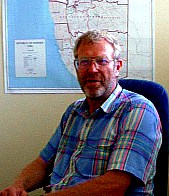It was one of the main reasons of our tour to visit that part of the coast
of Namibia which comprises its main harbor: Walvis Bay.
While the rest of Namibia became independent in 1990, Walvis Bay
remained South African until 1994.
In June 1997, I had been interviewed by a Danish company to serve as
team-leader for a DANCED foreign aid project dealing with
coastal zone management for the Erongo region.
The project was, however, awarded to another Danish company,
and I now had the pleasure of meeting their team-leader, Klavs Bender,
shown on the right, ensconded in the Prime Minister's office.

